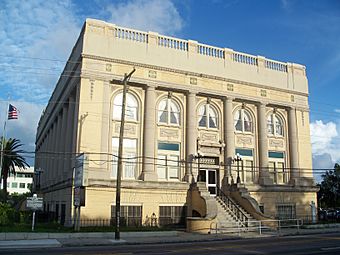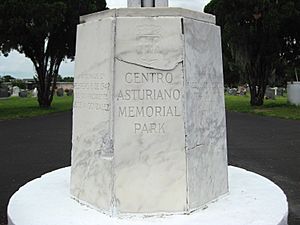Centro Asturiano de Tampa facts for kids
Quick facts for kids |
|
|
Centro Asturiano de Tampa
|
|
 |
|
| Location | 1913 North Nebraska Ave. Ybor City Tampa, Florida |
|---|---|
| Area | less than one acre |
| Architect | M. Leo Elliott |
| Architectural style | Beaux-arts Classical Revival |
| NRHP reference No. | 74000631 |
| Added to NRHP | 24 July 1974 |
The Centro Asturiano is a special historic building in Ybor City, Tampa, Florida. You can find it at 1913 Nebraska Avenue. On July 24, 1974, it was added to the U.S. National Register of Historic Places. This means it's an important place worth protecting. A famous Tampa architect named M. Leo Elliott designed the building.
Contents
What is the Centro Asturiano?
The Centro Asturiano de Tampa is a social club for people who came from Asturias, a region in Spain, and their families. For many years, if you were a member, you also got health care from a hospital, a place in the cemetery, and health insurance. The club's main goal was to look after its members throughout their lives.
Membership went down after the hospital closed in 1990. The old hospital building was later made into affordable homes for older people in 2005. Today, the Centro Asturiano is mostly a social club, and it still manages its cemeteries. This club is one of many "Centros Asturianos" found in Spain, the U.S., and other parts of the world.
How the Club Started
In the late 1800s, many people from Spain traveled to places like Havana, Cuba, to find work. Often, married men would move first and then send for their families once they were settled. In Havana, there were many groups that helped people from different parts of Spain. These groups offered health care and a "taste of home." The Centro Asturiano de La Habana was one of these groups, started in 1886. It provided medical help, social events, education, and fun activities.
Later, many cigar factories opened in Tampa, bringing new immigrants from Spain and Cuba. At that time, U.S. immigration rules made it harder for people from Europe to come, but not from Cuba. Antonio Gonzales Prado, who was the first president of the Havana club, came to Tampa. He helped create a committee to solve the problem of cigar workers not having health care. Another social club in Tampa, El Centro Español de Tampa, tried to create a health care system but didn't succeed.
It was very important to get approval from the main club in Havana for a new branch in Tampa. Some local doctors, pharmacists, and cigar makers formed a group to try and stop the new club from forming. However, the new club was approved. In 1968, the club's name officially became The Centro Asturiano de Tampa, Inc.
The Tampa branch, called La Delegation De Centro Asturiano De La Havana en Tampa, got its official permission in 1907. However, it didn't own the building or the hospital at first. The main club in Havana, Cuba, owned them.
The Hospital
On March 24, 1902, Dr. G.H. Altree offered his clinic to Centro members who needed medical help. By 1903, the club had grown so much that they had to rent hotel rooms for medical needs. The first Covadonga Sanitarium opened in 1905 with 54 beds. In 1927, a second, larger Covadonga Hospital was opened. Both hospitals were named after the Virgin of Covadonga. This name was chosen because many club members were Catholic.
In 1956, a new company called Centro Asturiano Hospital, Inc. was created. All the hospital buildings were moved to this new company. This was done so the hospital could get money from the government and other private groups.
Cemeteries
The Centro Asturiano created two cemeteries for its members and their families. The "Old" Centro Asturiano Cemetery was started in 1904. The city of Tampa gave the land to the club for this purpose. It is located in the Ybor City neighborhood at 2504 E. 21st Avenue. About 601 people are buried there, including Antonio Gonzales Prado, who helped start the club. He was buried there in 1904.
In 1942, the much larger Centro Asturiano Memorial Park was created. It is located near Tampa's eastern edge, just outside the city, at 5400 East Dr. Martin Luther King Jr. Boulevard. More than 2,300 people are buried here, or laid to rest in the mausoleum. The mausoleum was added in 1970 and made bigger in 1998.
A very important person buried here is Baldomero López. He was a U.S. Marine Corps First Lieutenant who bravely gave his life to save other soldiers during the Korean War. For his courage, he received the Medal of Honor. Many things are named after López to remember him, like a nursing home, a military ship, and a school in Seffner. The Centro Asturiano also put up a memorial for him near the entrance to the Memorial Park Cemetery.
The "OLD" Centro Asturiano Cemetery is actually at 3698 N. Ola Avenue. It's part of the Woodlawn Cemetery and is cared for by the City of Tampa Parks Department. This cemetery is still there today, but no new burials are allowed. It's important to know that 2504 E. 21st Avenue is the "OLD" Centro Español Cemetery, not the "OLD" Centro Asturiano Cemetery. Both served Spanish immigrants, along with the Centro Asturiano Memorial Park that is still used today.
The Centro Asturiano Today
After the hospital closed in 1990, fewer people joined the club. The club's main goal changed from providing medical care to keeping the club's history alive and focusing more on social activities.
The current building has been used since 1914. It originally had a floor for fun activities, a floor for studying, and a floor for parties.
- The first floor had a gym (now used for storage), a cantina for card and domino games, and a billiard room with five tables (now called the Covadonga Room, which can be rented). There was also a three-lane bowling alley, which is now a storage area.
- The second floor has offices for the club leaders, a large library, several rooms for reading and learning, and a smoking room also used for games. There's also a ladies' parlor and dressing lounge, and a big auditorium with a stage.
- The third floor has the balcony for the theater and a large ballroom.
The ballroom was, and still is, used for public dances. These dances were a big way for young club members to meet each other. Many current members met their spouses at a dance at the Centro. The ballroom is also used for private parties like birthdays, wedding receptions, and other celebrations. When the building opened in 1914, the Tampa Daily Times newspaper wrote about its design. They called it "a monument to the memory of those who have devoted their best endeavors to the welfare of the institution, and a palace to those who stand faithful to its noble ideals."
See also
 In Spanish: Centro Asturiano de Tampa para niños
In Spanish: Centro Asturiano de Tampa para niños


